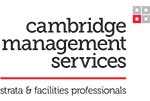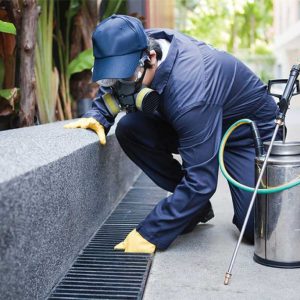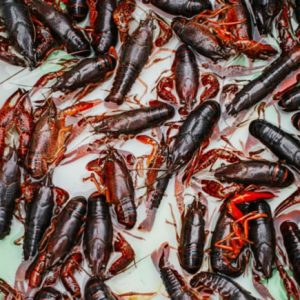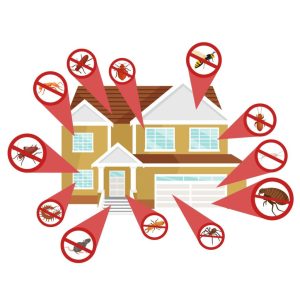
Guaranteed Safe and Effective Pest Control
Pest Control Sydney
We're the Masters of Pest Control in Sydney
- 40 Years Pest Control and Pest Inspection Experience
- Friendly, Honest, and Reliable Pest Control Team
- Courteous, Uniformed Professional Exterminators
- Full Home Pest Control Service
- Complete Commercial Pest Control
-
Stop Termites, Cockroaches, Rodents, Mice,
and Other Pests in Residential and Commercial Spaces
Tell us your pest problem
FREE QUOTE
Pest Control Services
Fully-Insured and Certified Pest Exterminators,
Servicing Sydney and Surrounding Suburbs
Why hire our pest control experts?
Our reputation as the "Masters of Pest Control" speaks for itself. We take great pride in upholding our name by providing top-quality pest control services.
Tailored Pest Control Solutions for Every Situation
What sets us apart is that we understand how each pest problem is different. We’ll take time to talk to you, assess the situation, and determine the right pest control strategy to protect your home or property from unwanted pests.
Comprehensive Inspections for Stress-Free Pest Removal
Our primary goal is to resolve your pest problem efficiently on the first attempt, ensuring a stress-free experience for you. Our thorough building and pest inspections cover all areas of the property, including the roof void, subfloor, wall cavity, and even the adjacent properties when needed. We leave no stone unturned in our efforts to provide a comprehensive pest control solution.
Effective, One-Stop Pest Treatment for Lasting Results
We guarantee effective pest removal, sparing you from multiple and costly treatments. With our skilled professionals and advanced techniques, we ensure complete eradication of pests, providing you with a pest-free environment that is worth every penny of your investment. Say goodbye to the hassle of dealing with pests and welcome a safe, clean, and comfortable space. When you book us, you’ll get your money’s worth!
Cost-Effective Residential and Commercial Pest Control Packages
Our approach involves a cost-effective, long-term pest treatment solution that ensures effective pest removal right from the first application. Regardless of the infestation’s scale, we are equipped to handle it with utmost care. Additionally, for larger or extended projects, we offer customisable residential and commercial packages that perfectly align with your budget.
Trusted pest exterminators in Sydney
As a top-rated pest control company, we are trusted by numerous satisfied clients for our commitment to excellence and exceptional results.
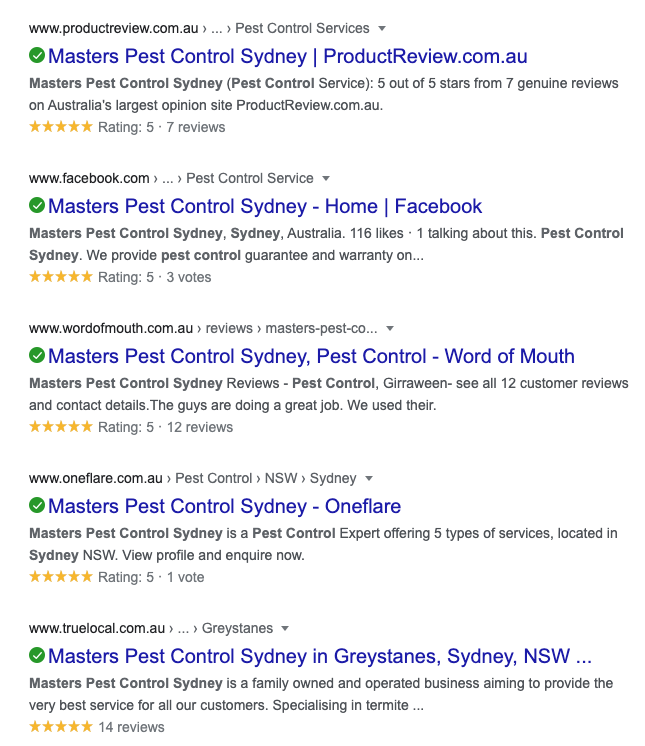
Masters Pest Control Sydney – Customer Reviews
We've Serviced Tens of Thousands of Homes and Businesses in Sydney
We’ve provided pest control services to over 10,000s of Sydney homes, duplexes, villas, cafes, local businesses, offices, warehouses, schools, hospitals, shopping centres, and more.
Chat now or call us on (02) 8007 4666!
Get a FREE, no obligation quote for a complete pest inspection and pest control treatment. We can work around your busy schedule or even on weekends for residential jobs.
Complete Pest Control Services
Our pest control team can handle all kinds of pests including termites, cockroaches, bed bugs, silverfish, and other insects, rodents and mice, and other common pests found in Sydney. To book a pest control service, chat with our team now or call (02) 8007 4666!

Termite Control
Our termite control services include termite barriers and baiting, white ant treatment and full termite inspection and prevention.

Pest Inspection
Yearly, bi-annually or pre-purchase home inspections. Pest reports for all building types using infra red technology to track pest activities.

Commercial Pest Control
Decades of experience delivering effective commercial pest control for Sydney businesses in the food, retail, healthcare sector, and other industries.
Residential Pest Control
Complete pest control for houses, duplexes, strata and other residential buildings. Stop rodents, termites, cockroaches, and other pests.
Cockroach Control
Protection against german cockroaches. Ideal for residential properties and businesses in Sydney such as cafes, restaurants, hotels, offices, etc.
Child and Pet-Friendly Pest Control
Safe and effective pest control using advanced, eco-friendly techniques.
Fully Licensed Building and Pest Inspectors
By law, anyone performing prescribed pesticide work are required to possess a license issued by the Environmental Protection Authority (EPA).
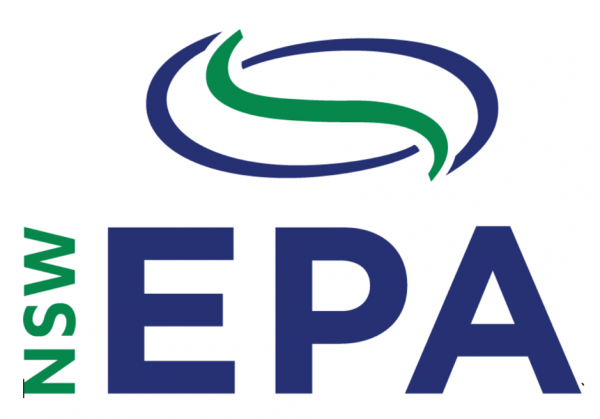
EPA NSW License
When you book us, you're hiring EPA NSW licensed pest control technicians.
Licensed and Fully Certified Pest Control Professionals
Our pest control team consists of accredited and licensed specialists who excel in effectively removing pests from both residential and commercial properties. Our professionals hold certifications in Occupational Health and Safety, Workplace Health Safety, and are also HACCP-certified for restaurant and food preparation spraying. We also hold the prestigious TERM SEAL certification for comprehensive termite protection.
Pest Control Solutions for Australian Brands
Trusted by Australia's biggest brands - Fully Compliant and Licensed Pest Exterminators

We’re proud to be a trusted name in pest control, servicing some of Australia’s most prominent brands. Our expertise extends to all residential property types, including homes, duplexes, villas, townhouses, as well as diverse commercial properties like schools, government buildings, councils, office towers, office blocks, restaurants, daycares, and hospitals. No matter the pest infestation, our comprehensive services encompass effective solutions, follow-up prevention, maintenance, and expert advice.
With over 40 years of building and pest control experience, we have earned the distinction of being one of Australia’s leading pest control companies. Our fully trained and licensed pest controllers are adept at a wide range of services, including pest control, pest prevention, fumigation, termite control, termite barrier installation, cockroach pest control, rodent or mice control, spider pest control, bed bugs removal, and more.
Masters Pest Control Sydney offers pest control Sydney-wide services. We are fully licensed pest controllers and building specialists who adhere to Australian pest control industry standards. With our 40 years of experience, we make sure that our clients are 100% satisfied with our service.
Read our customer reviews to find out more about what our customers have to say about our pest control services. We’re trusted all over Sydney
The Master's Pest Control Sydney:
Professional Pest Exterminators for Commercial and Residential Properties
Trusted pest control company by 10,000+ families, businesses and organisations in Sydney
Choosing Masters Pest Control Sydney means opting for reliable and effective pest control solutions. With our pest-free guarantee, decades of experience, competitive pricing, diverse services, and certified expertise, we ensure that your property remains free from pests. Trust our qualified team to deliver the highest quality service, backed by our commitment to excellence in every aspect of pest and termite control.
Pest-Free Guarantee: You can Trust in our Expertise!
At Masters Pest Control Sydney, we are confident in our abilities to deliver effective pest control solutions, and to prove it, we offer a pest-free guarantee for our clients’ peace of mind. Our team of qualified experts boasts decades of experience in the field, boasting an impeccable success rate in tackling pest infestations. With our comprehensive approach and proven techniques, we ensure your property remains pest-free, backed by our unwavering commitment to quality service.
Decades of Experience in Pest Extermination and Property Inspection
Experience is a testament to a pest controller’s expertise, and at Masters Pest Control Sydney, our track record speaks for itself. With 40 years of industry experience, our seasoned professionals have honed their skills in handling various residential and commercial properties. Drawing from this wealth of knowledge, we tailor our solutions to meet the unique needs of each client, guaranteeing effective and lasting results.
Wide-Range of Proven Pest Control Services
The diversity of services a pest controller offers reflects their experience and expertise. At Masters Pest Control Sydney, we take pride in being a one-stop solution for pest and termite control needs. Our services cover a wide range of properties, including residential and commercial buildings. Whether you are dealing with insects, rodents, or termites, we have the knowledge and tools to handle it all effectively.
Competitive Pricing without Compromising Quality - $187 Complete Pest Control
Our dedication to delivering top-notch service means that we offer competitive pricing without compromising on quality. As a reputable company, we are not driven by desperation; instead, we focus on delivering value to our clients.
When shopping around for pest control services, compare quotes, and you’ll find that our pricing aligns with the excellence we bring to each job.
Certified Pest and Termite Control Specialists
Pest management strategies are critical, particularly when dealing with the challenge of termites. At Masters Pest Control Sydney, we are certified specialists in termite control, offering effective and thorough termite inspections and treatments.
Our team is equipped with the necessary training and certifications to handle wide-scale termite control, providing you with the confidence that your property is in capable hands.
Eco-Friendly and Child and Pet-Friendly Pest Control Options
Our expert team employs environmentally-friendly pest control techniques that have minimal impact on the ecosystem. We use non-toxic products that target pests effectively while being gentle on the environment. With our child and pet-friendly approach, you can have peace of mind, knowing that your little ones and furry companions are safe from any harmful chemicals or treatments.
Helpful Pest Control Articles
All Year Round Pest Protection
Protecting homes and businesses from common pests in Australia
Building and Pest Inspections
Building and pest inspections are essential to prevent pest infestations in residential and commercial properties. These inspections are necessary to identify potential pest problems before they become major issues. Building inspections assess the structural integrity of the building, while pest inspections identify the presence of pests such as termites, rodents, ants, cockroaches, and other insects.
A thorough building and pest inspection involves examining the entire property, including the interior and exterior walls, roof, flooring, and other areas where pests may thrive. Inspections typically include the use of tools such as moisture meters and thermal imaging cameras to identify potential pest problems. These inspections are typically conducted by licensed and experienced professionals who are trained to identify potential issues and provide recommendations for effective pest control.
Annual Pest Prevention
By identifying potential pest problems early on, building and pest inspections can save property owners time, money, and stress. Preventive measures such as regular maintenance, cleaning, and repairs can be implemented to prevent pests from gaining access to the property. Additionally, effective pest control measures such as baiting, trapping, and fumigation can be put in place to eliminate existing pest problems.
Overall, building and pest inspections are an essential part of maintaining a pest-free environment. Property owners should schedule regular inspections to identify and address potential pest problems before they become major issues. By working with a licensed and experienced professional, property owners can ensure that their property remains pest-free and safe for occupants.
INSECT CONTROL in Sydney
Our pest control team services the entire Sydney Metropolitan and Suburbs in and around Sydney NSW
Insect control is a vital aspect of ensuring a safe and healthy home environment. Various household pests, such as ants, termites, silverfish, dust mites, bed bugs, mosquitoes, wasps, spiders, fleas, and flies, can not only cause damage to your property but also pose a threat to your health. Book our team to effectively control and prevent common pests from infesting your home.
We remove all kinds of bugs and insects.
-
Cockroaches: Cockroach control begins with a comprehensive inspection of the property to locate cockroach hiding spots and potential entry points. Using safe and targeted insecticides, our pest control team treats these areas to eradicate existing cockroaches and establish a protective barrier, preventing future infestations and ensuring a cockroach-free environment.
-
Spiders: Professional spider control involves a thorough inspection of the property to identify spider hotspots and potential entry points. Utilising safe and effective insecticides, our pest exterminators target these areas to eliminate existing spiders and create a barrier that deters future infestations.
-
Ants: Professional ant control involves identifying ant colonies and their entry points during a comprehensive inspection. Our pest exterminators apply specialised insecticides that target and eliminate ant nests and trails. Additionally, a protective barrier is established to prevent ants from reinfesting the treated area.
-
Dust Mites: To control dust mites, our trained experts conduct a thorough assessment to identify areas with high dust mite activity. Effective allergen-reducing treatments are applied to eradicate dust mites, reducing allergen exposure. Preventive measures, such as regular cleaning and maintaining low humidity, are implemented to minimise future dust mite presence.
-
Bed Bugs: Professional bed bug control begins with a detailed inspection to locate bed bug hiding spots and infested areas. Targeted treatments, such as heat or insecticides, are precisely applied to eliminate bed bugs and their eggs. Regular follow-up inspections are conducted to ensure complete eradication and prevent any potential resurgence.
-
Mosquitoes: In mosquito control, thorough inspections are carried out to identify breeding sites and resting areas. Expert exterminators apply larvicides to target mosquito larvae, disrupting their development. Additionally, mosquito repellents are used to deter adult mosquitoes and reduce their presence in the treated area.
Maintain an insect-free environment by booking our pest control professionals.
-
Termites: Termite control involves conducting extensive inspections to identify termite colonies and entry points. The use of specialized termiticides, such as Termidor and Premise, is employed to effectively eliminate termites and their nests. Additionally, baiting systems may be installed to target termites foraging around the property, leading to colony elimination.
-
Wasps: In wasp control, our expert pest controllers locate and assess wasp nests during inspections. Protective clothing is worn while using appropriate insecticides to remove the wasp nests safely. Preventive measures may also be taken to deter future wasp infestations, such as sealing potential entry points.
-
Fleas: To control fleas, a detailed inspection is conducted to locate areas of high flea activity. Our pest exterminators apply insecticides with flea-targeting properties to treat infested areas. Regular vacuuming and washing of pet bedding are recommended as preventive measures to reduce flea populations.
-
Flies: In fly control, inspections are carried out to identify breeding sites and resting areas. Fly traps and sticky tapes may be used to capture adult flies. Additionally, measures such as proper waste management and maintaining clean environments help prevent fly infestations.
-
Silverfish: Professional silverfish control involves identifying areas with high silverfish activity during inspections. Insecticides with silverfish-targeting properties are applied to eradicate existing populations. Preventive measures, such as reducing humidity and sealing cracks, are implemented to deter future silverfish infestations.
Remember, maintaining a pest-free home environment involves a combination of professional pest control services and consistent cleaning and maintenance efforts. By implementing pest control precautions and seeking professional help when necessary, you can effectively prevent and control household pests, ensuring a healthier and safer living space for you and your family.
Termite TreatmenTs
Avoid costly damages to your property by preventing a termite infestation
Termites
What makes termites dangerous?
Termites pose a significant problem for homeowners and businesses alike, causing widespread damage to structures and leading to substantial financial losses. As one of the most destructive insect pests globally, these wood-devouring insects can wreak havoc on homes and properties. Recognising the signs of a termite infestation is crucial, and immediate action is necessary to prevent further destruction. However, it is vital to refrain from attempting DIY termite treatments, as these pests require a professional approach for effective eradication and long-term control.
Understanding the Severity of a Termite Problem:
Termites are notorious for their destructive behavior, devouring anything made of wood and causing extensive damage in and around properties. The financial repercussions of termite infestations have been felt by countless homeowners and businesses, making it essential to address the issue promptly.
Recognising the Signs of Termites:
Being proactive is key to minimising termite damage. Look for telltale signs such as discarded wings, mud tubes, and wood damage around your living areas. If any indicators are present, it is crucial to act swiftly to halt their progress.
Avoiding DIY Insecticide Sprays:
While DIY insecticide sprays may work for some pests, they are not suitable for termite treatment. Attempting to handle a termite infestation without professional assistance can lead to them retreating to their nest, making subsequent treatments more challenging. Engaging a professional pest controller is the most effective approach.
The Importance of Professional Termite Treatment:
Termite treatment requires a comprehensive plan and specialised expertise. Calling in a qualified pest controller ensures that a thorough termite inspection is conducted to identify the nest’s location and assess the extent of the infestation. Based on their findings, the pest controller will determine the appropriate eradication method.
When it comes to termite infestations, swift and decisive action is essential to prevent further damage to your property. Avoid the temptation to handle the issue with DIY insecticide sprays, as this may exacerbate the problem. Instead, seek the expertise of a professional pest controller who can provide a well-thought-out treatment plan and effectively eradicate termites from your home or business. By investing in professional termite treatment, you safeguard your property and mitigate potential financial losses caused by these destructive pests.
-
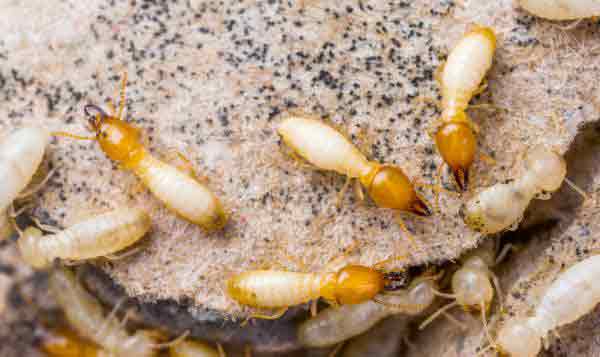
Termites or White Ants
Termite removal
Discovering signs of termite damage in your home, such as a hollow sound when tapping on doors or mud tubes along walls, is a cause for immediate concern. When facing a termite infestation, seeking professional assistance is crucial to ensure effective removal and prevention of further damage. The experts at Masters Pest Control Sydney offer swift and reliable solutions to tackle these wood-eating pests, employing a variety of proven methods for termite control.
Baits: Targeted Poisoning for Entire Colony Elimination
One effective method employed by professional exterminators is baiting. These baits, constructed from cellulose-rich materials like wood and cardboard, are infused with pesticides. When termites consume the baits, they inadvertently carry toxic particles back to their nests, poisoning the entire colony. This strategic approach ensures the elimination of termites at the source, providing a long-term solution to the infestation.
Repellents: Creating an Impenetrable Termite Barrier
Repellents offer another effective way to combat termite infestations. Composed of substances poisonous to termites, these repellents discourage termites from infiltrating specific areas and forming additional colonies within the inner walls of your home. Acting as a foolproof termite barrier, repellents stop termites in their tracks, preventing further damage and protecting your property from their destructive behavior.
Termiticides: Powerful Elimination for Extreme Infestations
Professional exterminators rely on termiticides such as Termidor and Premise for extremely infested areas. These potent products are ideal for tackling severe termite problems, as they swiftly and efficiently kill termites, leaving no survivors. Hundreds of gallons of termiticides can be expertly pumped into termite nests, ensuring the destruction of eggs before they even hatch, eradicating termites at all stages of their life cycle.
When facing a termite infestation, swift action is essential to prevent further damage to your home. By entrusting your termite extermination to the experienced team at Masters Pest Control Sydney, you gain access to a range of effective methods for termite control. Baiting ensures the poisoning of entire termite colonies, while repellents create impenetrable barriers, stopping termites in their tracks. For severe infestations, powerful termiticides deliver comprehensive elimination, leaving no room for these destructive pests to thrive. Protect your home from the devastating effects of termites by seeking professional extermination solutions today.
Termite Barriers and Termite Baits
Termite barrier and termite baiting systems to prevent and protect against termite infestations
Physical Barriers
Physical barriers include those that are made of stainless steel mesh or sand and basaltic particles. These are wide sheets that are layered underneath the slab of your house. This type of barrier can also be laid around the perimeter of the slab and pipe penetrations. It is all based on your property’s needs.
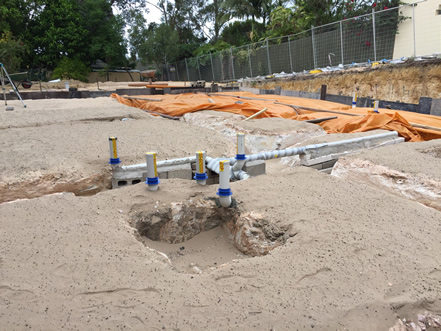
Chemical Termite Barriers
Typically, physical barriers are made to isolate the pre-existing termite colony. The termite barrier provides termite protection from further attacks as it reduces entry points to a designated termite inspection zone. Physical termite barriers are commonly used for termite protection and termite control purposes for new construction projects.
Chemical Barriers
On the other hand, chemical barriers are, as the name suggests, made with active ingredients. These can be anything from plastic barriers that are infused with termiticide or soil treatments. The formula works to kill termites until the entire colony is wiped out. Despite being lethal to termites, this type of barrier is designed to be safe around humans and animal.
Why are termites so common in Sydney?
Sydney is a breeding ground for termites because of its climate and environment. There are at least 300 species of termites in Australia alone. Termites are one of the most common pests found throughout Sydney and the rest of the country.
Termites are found throughout the year but swarm during certain seasons. The common subterranean termites typically come out during spring and summertime. These insects prefer a warm climate and are often found in moist or damp areas. Meanwhile, dry wood subterranean termites come out by the end of summer or during the fall season.
Cockroach Control
for Homes and Businesses in Sydney
Eradicate German Cockroaches from Your Property - Book a Pest Inspection Today!
Masters Pest Control has successfully exterminated cockroaches in many south-western business parks. From our experience, we have found that the best method to protect against a roach infestation is by removing all possible sources of water for these bugs. Complete any plumbing modifications, and don’t hesitate to repair leaking pipes or taps. We have come across numerous homes whose cockroach infestation problem could have been easily prevented by fixing leaking plumbing. This is the perfect and most logical way to start your pest removal campaign.
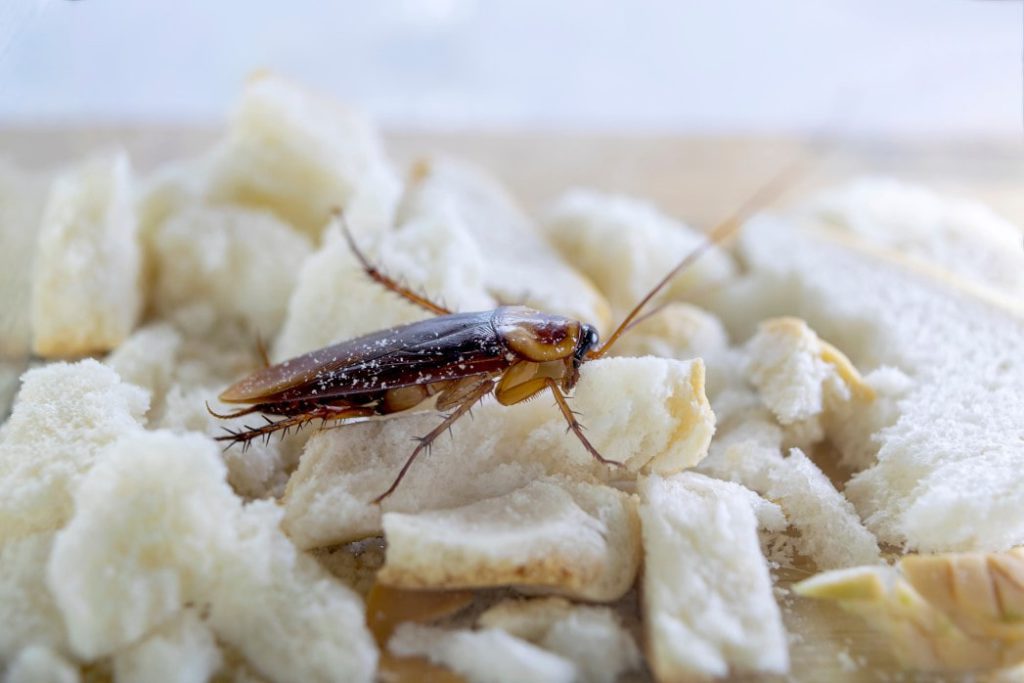 Cockroaches: A Persistent Nuisance
Cockroaches: A Persistent Nuisance
At Masters Pest Control in Sydney, we specialise in dealing with the persistent nuisance of cockroaches. These unsightly pests require food and water to survive and thrive in dark, damp environments, becoming most active during the night. Commonly found in kitchens and bathrooms, cockroaches are often spotted after the lights have been turned off for a while. While proper sanitation helps, it alone cannot eliminate these resilient creatures. Simply relying on bug sprays is not sufficient, as cockroaches are resistant to household insecticides and reproduce rapidly in large numbers.
Addressing the Root of the Cockroach Problem
At Masters Pest Control, we understand that tackling a cockroach infestation requires a comprehensive approach. While maintaining cleanliness is essential in minimising their attraction, it is not enough to eliminate them entirely. Our experienced team employs specialised techniques and targeted treatments to address the root cause of the infestation. We aim to create a lasting solution that not only eliminates existing cockroaches but also prevents future infestations.
Customised Cockroach Control Strategies
Each cockroach infestation is unique, necessitating tailored strategies for effective control. Our experts conduct a thorough inspection to identify the extent of the problem, their entry points, and nesting areas. Based on this assessment, we design a customised cockroach control plan, combining the use of safe and environmentally-friendly products with advanced pest control methods.
Resilient and Rapid Reproduction
Cockroaches possess remarkable resilience, making them difficult to eradicate with conventional insecticides. Moreover, they reproduce quickly, compounding the infestation problem. Our dedicated team understands their behavior and employs innovative techniques to disrupt their life cycle, curbing reproduction and effectively reducing their numbers.
Safeguarding Your Home with Expert Cockroach Control
By choosing Masters Pest Control, you can rest assured that your home will be protected against these persistent pests. Our specialised cockroach control services go beyond surface-level treatment, providing you with a thorough and long-lasting solution. We take pride in our ability to tackle cockroach infestations head-on, ensuring your living space remains clean, safe, and cockroach-free. Don’t let cockroaches take over your home; trust our experts to bring swift and effective relief.
Rodent and Mice Control
for Residential and Commercial Properties
Common Invasive Rodent Species in Sydney
Norway Rat
Also known as Sewer rats, these larger rodents live at ground levels and nest in basements and attics. They damage materials and can transmit diseases like plague and rat-bite fever.
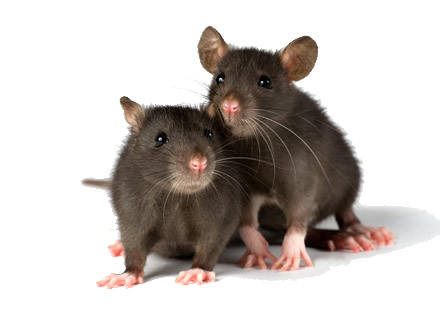
House Mice
These mice colonise various habitats, including homes. They contaminate food and can transmit diseases like Salmonella and tapeworm.
Roof Rat
Originally from South East Asia, these rats have brown fur with black spots, large ears, and long tails. They often nest in upper building parts and can spread diseases like typhus and Salmonella.
What are the common ways to control a rodent or mice infestation?
1. Rodent or Mice Baits
Rodent baits are a common method for controlling mouse and rat infestations. These baits are designed to attract rodents with their scent and taste. They contain a toxic substance that, when ingested by the rodents, disrupts their internal systems, leading to eventual death.
To reduce the risk of secondary poisoning or unintended harm to non-target animals, rodent baits are often placed inside specially designed bait stations. These stations serve as protective enclosures that rodents can access while keeping the bait secured.
By using bait stations strategically, you can control where the bait is placed, making it less accessible to pets and other animals, and ensuring it remains attractive to the target rodents.
2. Snap Traps
Snap traps are mechanical devices used for capturing rodents like mice and rats. They operate using a spring-loaded mechanism that snaps shut with considerable force when a rodent interacts with the bait. This force is typically sufficient to kill or incapacitate the rodent instantly. Snap traps offer a more humane alternative to poison baits, as they result in a quick and potentially less painful death for the captured rodents. They are also considered more environmentally friendly, as they don’t introduce toxins into the ecosystem.Snap traps are mechanical devices used for capturing rodents like mice and rats. They operate using a spring-loaded mechanism that snaps shut with considerable force when a rodent interacts with the bait. This force is typically sufficient to kill or incapacitate the rodent instantly.
Snap traps offer a more humane alternative to poison baits, as they result in a quick and potentially less painful death for the captured rodents. They are also considered more environmentally friendly, as they don’t introduce toxins into the ecosystem.
Snap traps are commonly used for monitoring rodent activity, and their effectiveness can be enhanced by placing them in areas where rodents are likely to travel, such as along known pathways or near burrows.
3. Tracking Powders
Tracking powders are a specialised type of rodent control method. They are typically applied to burrows and areas where rodents leave rub marks, such as walls and surfaces.
These powders often contain toxic substances that are ingested or picked up by rodents as they move through treated areas. The primary purpose of tracking powders is to trace rodents back to their nests.
By observing the trail of powder left by the rodents, pest control professionals can identify nesting sites and target them directly for treatment.
Tracking powders are a valuable tool in rodent control, especially when it’s necessary to locate and eliminate entire nests to effectively manage infestations. However, their use should be handled with care to minimise exposure to non-target animals and pets.
If rodent issues persist or are beyond your control, seek professional assistance from our rodent pest control team.
Residential Pest Control
Servicing all homes, duplexes, townhouses, villas, strata housing, condominiums, and apartment buildings across Sydney and nearby suburbs
Are you looking for a pest control company near you? With over 40 years of experience, Masters Pest Control is one of Sydney’s most trusted pest control companies. Our team of highly trained professionals prioritises the safety of your loved ones. During the on-site assessment, we note any possible allergic reactions to chemicals and advise you accordingly. Our team makes use of products that are guaranteed to be safe for household pets. It only requires a quick phone call to your local pest control expert to ensure your peace of mind. When you ignore pest problems like cockroaches, rats, spiders, and termites, the damage to your property can add up to thousands of dollars.

Masters Pest Control Sydney provides mobile service to all suburbs.
Instead of using hazardous over-the-counter bug sprays, why not choose a safer way to get rid of pests? We offer child and pet-friendly pest control services throughout Sydney. Our licensed pest exterminators handle all types of pests, including termites, cockroaches, rodents, flies, bed bugs, and more. We also provide pre-construction (termite barrier) and building pest inspections all over Sydney, including Western Sydney, Penrith, Blacktown, Parramatta, Campbelltown, Hills District, and Eastern Suburbs.
What sets us apart is that we understand how each pest problem is different. We take the time to talk to you, assess the situation, and determine the right pest control strategy to protect your home or property from unwanted pests. We aim to solve your pest problem the first time and make your experience as stress-free as possible. We guarantee effective pest removal so you can say goodbye to multiple and costly treatments. When you book with us, you’ll get your money’s worth!
Check all our Sydney locations here. Book a building and pest inspection or a pest control service by calling (02) 8007 4666.
Sydney-Wide Home Pest Control Service
Residential Pest Infestation Assessment and Property Inspection
Our pest exterminators in Sydney provide full-proof pest control treatments and proper documentation that you can review. We offer home pest control and commercial pest control services for restaurants, hotels, offices, hospitals, and more.

Residential and commercial pest inspection service with the help of Masters Pest Control
If you are in a high-risk industry, sometimes even doing all the right things is not sufficient. That’s why it is advisable to consult the experts when it comes to dealing with nasty pests. We provide full pest control treatments and provide proper documentation that you can review. In addition, we offer both home pest control and commercial pest control services for restaurants, hotels, offices, hospitals and more.
Keeping your business pest-free is not be as easy as using over-the-counter remedies. Some property owners may even be too busy to maintain their properties or take precautionary measures to keep pests away. In such cases, we recommend that you seek our help to avoid incurring any fines. We understand the problem and know exactly how to eliminate any pests commonly found in commercial and urban areas.
If you’re running a business, we recommend that you seek professional advice when dealing with a stubborn pest infestation to avoid incurring fines. We understand the problem and know exactly how to eliminate any pests commonly found in commercial and urban areas. So schedule a pest inspection today!
Commercial pest control
Servicing ASX Listed Companies, Franchises, Entertainment, Hospitality - Sydney-Wide Pest Control Services
Trusted by Businesses
Customer Service is our #1 Priority
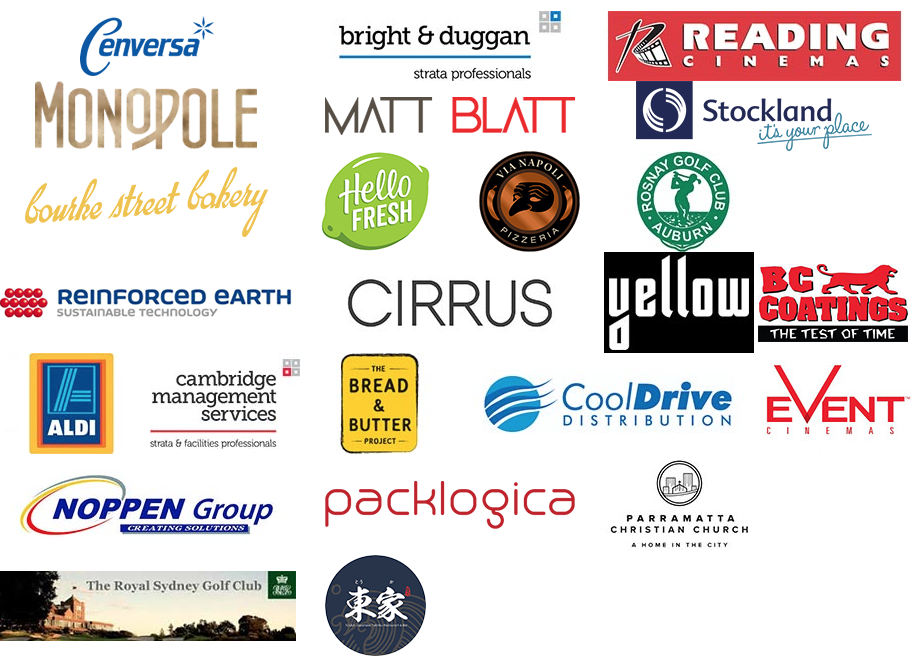
Famous Household Brands We Service
There is no job too small or big for our team. We have local professional pest controllers available in the suburbs across the region.
Is your business at risk? Termites don’t seem to care what kind of property you are. They are hungry and will destroy your company’s walls from the inside out. Masters Pest Control is here to help! Equipped with many years of industry experience and expertise, our professionals are well suited for any commercial termites control task you may have. The pest management strategies we use involve a combination of chemical and organic pest control methods. No matter what your business may be, we can tailor our extermination methods accordingly. We have experience working with a range of commercial properties, including florists, food outlets and even hotels.
Masters Pest Control Sydney recommend you have annual inspections for your business to avoid future infestations. We can protect the internal structure of your business’s property with our effective termite protection strategies. We will create an impenetrable termite barrier to stop all those mischievous white ants from coming in. Alternatively, if your company is already showing signs of termite infestation, we will provide the proper termite treatment situation promptly and completely. We understand you still have to operate your company, so our service team are happy to come in before and after working hours.
Central Hills Business Park
Home Centre Gregory Hills Stage-1 is due for completion in Dec 2014. The Central Hills Business Park is an impressive 45-hectare business park situated at Gregory Hills in south-western Sydney. More than 90% of this business park has now been either leased or sold. However, some limited high-quality development opportunities for lease/sale remain.
Macquarie Park
This is a very vibrant business district on the rise and is the head office location for many ASX-listed companies. It has a campus-style, collaborative work environment & expansive floor plates that give you enough space to create & encourage interactivity & employee engagement.
Pest Control for Local Businesses
Commercial tenants
Sydney Business Park
This is a new master-planned and mixed-use commercial precinct that is strategically situated on the M7.
Sydney Corporate Park
This is a unique and vibrant destination where business and office folk can work, socialise, work out, entertain & enjoy. This is truly a complete business space, and apart from the office and corporate areas has an impressive entertainment precinct with indoor skiing and trampolining. It also has several sports & retail facilities and a brewery & several café options. It is situated in Alexandria right on Bourke Rd & O’Riordan St.
Quad Business Park (Sydney Olympic Park)
Quad Business Park is essentially a 4-stage integrated office development that is situated at Sydney Olympic Park. It is made up of 4 office buildings that total 24,300 sqm of net lettable space. It is also the winner of the PCA Industrial & Business Park Award 2009.
Lakes Business Park
This is a premier Business Park located in South Sydney and is home to over 50 successful companies like Telstra, Bosch, Sunbeam & Mazda, to name a few. It has a tranquil and natural lake setting, 1st-class licensed Café, onsite parking and a Conference Centre, all of which make working at this fantastic business park an enjoyable experience.
Australian Technology Park
ATP is a very vibrant & sustainable business place that combines cultural & industrial heritage, encourages investment, provides jobs and supports collaboration and innovation. It is spread over around 14 hectares of campus-inspired grounds. It features a unique integration of different heritage architecture and premium commercial space, and state-of-the-art and elaborate conferencing facilities. It is home to various leading Australian & global IT, communication as well as science companies.
Lane Cove Business Park
This Business Park provides a very diverse range of cost-effective business premises located on the lower North Shore. These are conveniently located adjacent to the orbital road system on Epping Road near Sam Johnson Way. Lane Cove West Business Park effectively offers a pleasant & and uncluttered working environment for various businesses.
Gateway Business Park
This is a modern office & office-warehouse business park situated in the heart of Sydney. It has more than 19,000 square meters of high-quality commercial office & office-warehouse accommodation. This estate also has the ability to tailor any specific space requirements to match the individual needs of the tenants. The industrial units also offer direct container access for unloading and loading.
Norwest Business Park
The Norwest Business Park is a very thriving business community that is strategically situated with direct access to the orbital motorway system in Sydney and provides effortless access to the Central Business District, the airport and the manufacturing & distribution heartland of the city.
GUIDE: Pest Control to Protect Your Property Against Rodents, Cockroaches, Termites, and Other Insects
Some things to know when protecting your home from common pests
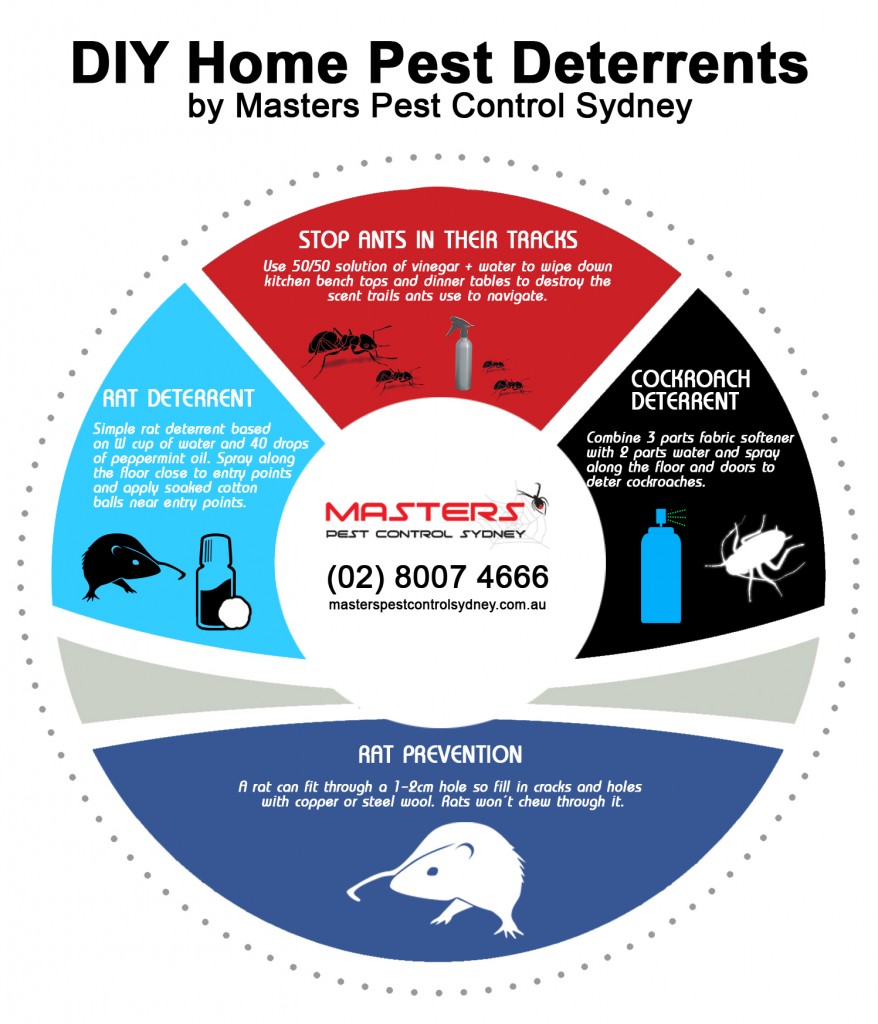
Effective and Environmentally-Friendly Pest Sprays
Termites: A Costly Threat to Australian Properties
Termites wreak havoc on properties across Australia, causing millions of dollars in damages each year. To safeguard your investment, regular building and pest inspections, along with termite treatments, are crucial. At Masters Pest Control, we offer comprehensive termite control services, including the installation of termite barriers, baiting, prevention, and protection, ensuring your property remains termite-free.
Choosing the Right Pest Spray: Balancing Efficiency and Safety
Pest sprays are the primary weapon in a pest control expert’s arsenal, offering effective solutions for pest eradication. However, not all pest sprays are equal, and their incorrect application can harm your family, pets, and the environment. As a family-owned business, we prioritize safety and sustainability, using only safe and environmentally-friendly pest control solutions.
Termidor: Advanced Non-Repellent Liquid Technology
Termidor, our preferred pest spray, targets native subterranean termites, Formosan termites, and dry wood termites prevalent in the Sydney climate. Employing an advanced non-repellent liquid technology, Termidor remains undetectable to termites, making them unknowingly come into contact with and ingest the solution, leading to their inevitable demise.
Leveraging the “Transfer Effect” for Maximum Impact
Termidor’s effectiveness is enhanced by the “Transfer Effect,” capitalizing on termites’ social behavior. Through trophallaxis, termites transfer Termidor throughout the colony, ensuring even those not directly exposed to the spray are affected, resulting in comprehensive termite control.
Pyrethrum: Nature’s Organic Insecticide
For general pest control, we rely on Pyrethrum, an organic insecticide derived from the pyrethrum daisy. This natural pest deterrent affects the central nervous system of cockroaches, mosquitoes, spiders, and similar insects. In low doses, pests avoid treated areas, while higher concentrations disable their ability to move, leading to their ultimate demise.
Safe and Environmentally-Friendly Pest Sprays for Effective Results
Our commitment to safety and the environment drives our choice of pest sprays. Termidor and Pyrethrum exemplify our dedication to offering effective and sustainable pest control solutions. Rest assured that our expert team employs these environmentally-friendly pest sprays to keep your property free from pests while preserving the well-being of your family and the ecosystem.
Common Pest Control Misconceptions
As homeowners, we all have experience dealing with pests. From tiny creepy crawlers like termites to small animals like rats, these pests can damage your property if not addressed quickly. So having a regular pest examination and treatment is a no-brainer. And yet, not everyone is convinced that pest control is a necessity.
There are a lot of misconceptions on pest control circulating the internet. To help you separate the facts from fiction, let our pest control experts at Masters Pest Control shed light on some of these myths. In addition, here are tips to help protect your property.
1. You don’t need pest control if you don’t see pests.
Not seeing any crawling critters is not evidence that they are absent. In fact, pests are actually good at hiding in your home’s nooks and crannies. Termites, for example, can build their homes deep underground and may have eaten the inside of your home before noticing them.
2. Termites only eat wood.
You would be wrong to think you are safe from a termite infestation if your house is not made of wood. Termites eat wood, but what they are really after is cellulose, the material wood is made of. These pests will feed on anything made of cellulose—books, documents, clothes, photographs or any plant by-product.
3. Cockroaches only live in dirty environments.
While these pesky critters prefer damp and dirty places, it doesn’t mean that a clean home cannot have cockroaches. As long as they have food and water to sustain them, they can live in a clean, well-maintained home.
4. The most effective bait for rats is cheese.
Multiple cartoon shows from our childhood show that cheese can entice rats into traps. In reality, rats will eat anything, but they prefer sweeter food, such as fruit and grain. So next time you are setting a trap, you might want to put a bit of cereal or peanut butter instead.
5. Your cat is the best rat control expert.
We recognise your pet cat and all other pet cats in Sydney as our partner in the pest control industry. However, there are some areas in your home that even your pet cat cannot reach. Rodents also reproduce quickly, and your cat may not be able to handle the spread of a rodent infestation.
6. Pest control in Sydney is expensive.
Pest control price actually depends on the type of treatment you are getting and the size of your home. Pest control in Sydney is actually affordable. The most expensive is termite treatment largely because of the extent of the damage they could do to your home.
7. Pest control chemicals are toxic.
Innovations in the pest control industry have led to the development of green pest control methods. Our experts at Masters Pest Control put your health and safety as our top priority. We use a low-toxicity and environmentally-friendly pest control treatment method that is safe for your family but still effective against pests.
(RELATED: Child-friendly and pet-friendly pest control)
8. Store-bought pesticides work just as well.
Off-the-shelf insect sprays can be effective for small infestations but not enough for large-scale ones. Pest control experts have the license to use stronger-grade pesticides that are more effective than store-bought sprays.
9. Professional pest control is a waste of money.
Many homeowner fears about pest control come from the misconception that the pests come back anyway, even if you hire a pest control expert. However, effective pest management goes beyond just spraying pesticides and calling it a day. Pest control experts will place safeguards to prevent the infestation from recurring and may even offer a warranty.
Request a free quote to protect your property from common pests
Servicing Sydney Metropolitan, All Sydney Suburbs and Nearby Areas



















